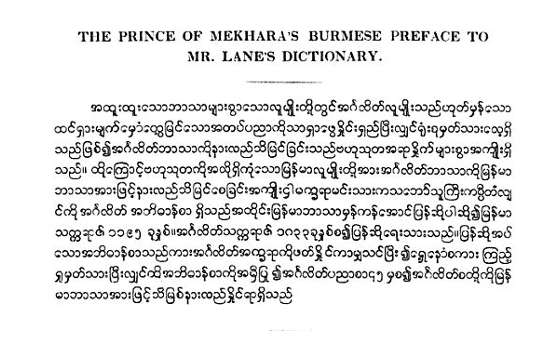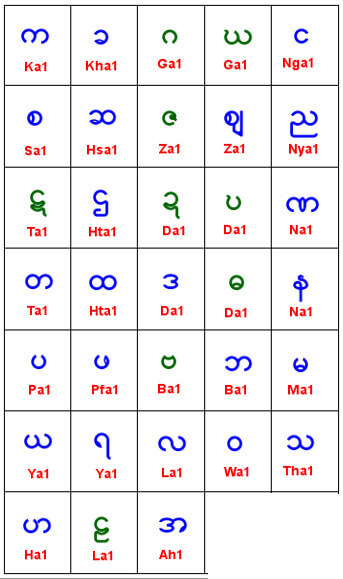A Brief History of Burmese Script
Historical evidence suggests that Myanmar Script has existed as far back as 11th Century Bagan Civilization. The living historical evidence is the 12th century Mya Zedi Pillar Script engraved in Mon, Myanmar, Pali, and Pyu languages. It is possible that some variants of Brahmi and Pyu scripts of the earlier Pyu city-states were in use in Bagan before adapting to the Mon script by King အနော်ရထာ | a-nau2-ra1-hta2
![]() to transfer the knowledge of Tharavada Buddhism from the Mon.
to transfer the knowledge of Tharavada Buddhism from the Mon.
COMPARISON TABLE OF MYANMAR, MON, PYU, AND BRAHMI SCRIPTS in the Myanmar-English dictionary published by the Department of the Myanmar Language Commission shows that 11th century Myanmar Script is closer to the Mon Script than Pyu script. But, note that Old Mon Script has missing 12th, 14th, and 32nd characters ဌ - ဎ - ဠ which look more like variants of Pyu and Brahmi.
Pyu script, just like Mon Script, was derived from the original Brahmi script of ancient India shown in the left column of the table.
To give a sense of timeline in history, Ancient Pyu script was in use as far back as 4-6 AD. In comparison, Old English based on Latin script was introduced to the Anglo-Saxon people of England in the 7th century, and Modern English began in the late 15th century. The works of William Shakespeare dated back to the early 17th century.
Dr. Judson, an American Missionary, who made a thorough study of the Burmese language theorized in his book GRAMMAR OF THE BURMESE LANGUAGE, published in 1883 that Burmese alphabet is modification of the ancient Nagari Script just like Pali, but not a modification of Sanskrit.
However, it should be noted that Sanskrit is the Language just like the Pali, and both the languages can be written in different scripts including Nagari, Devanāgarī, or even in modern English and Burmese. Nagari is said to be the old term for Devanagari, which itself is the Brahmic family of scripts, so most researchers today will agree with Dr. Judson.
As seen in the COMPARISON TABLE, shapes of several Burmese characters had evolved throughout the centuries to the present day print form. With the rise of "Bamar" people, Burmese script became the dominant script replacing Mon and Pyu in the land of what is known as Myanmar today. By the 18th century with the advent of printing, the shapes of all the 33 main characters had become almost identical to the present day characters.
The first Burmese book: Alphabetum Barmanum sev Bomanum Regni Avae Finitimarumque Regionum was first printed in 1776 AD (1138 Burmese Calendar year) in Rome by Typis Sacrae Congreg. de Propaganda Fide (Sacred Congregation for the Propagation of the Faith.) It is said to contain 60,000 Burmese typographic characters.
The first English to Burmese dictionary by the Englishman Charles Lane with the help of Burmese prince မက္ခရာမင်းသား | met-kha1-ya2 min3-tha3 - Mekkhaya was published in 1841. The sample below shows the printed Burmese Script from this dictionary. Although some of the spellings have changed since then, characters have the same shapes as the present day computer fonts. Also note that the 27th Burmese character ရ | Ya1 in the Prince's name was pronounced with "R" sound instead of "Y" as met-kha1-ra2.

Yadanabon Naypyitaw Newspaper was first published on 24 March 1874 by Yadanabon Naypyitaw Press in Mandalay during King Mindon era.
(Reference: Rare Book Collection of National Library, Myanmar by By MYA OO, Director of the National Library of Myanmar.)
Today, just about anyone with a computer using Burmese font can print in Burmese. Spellings are standardized by Myanmar Language Commission.

